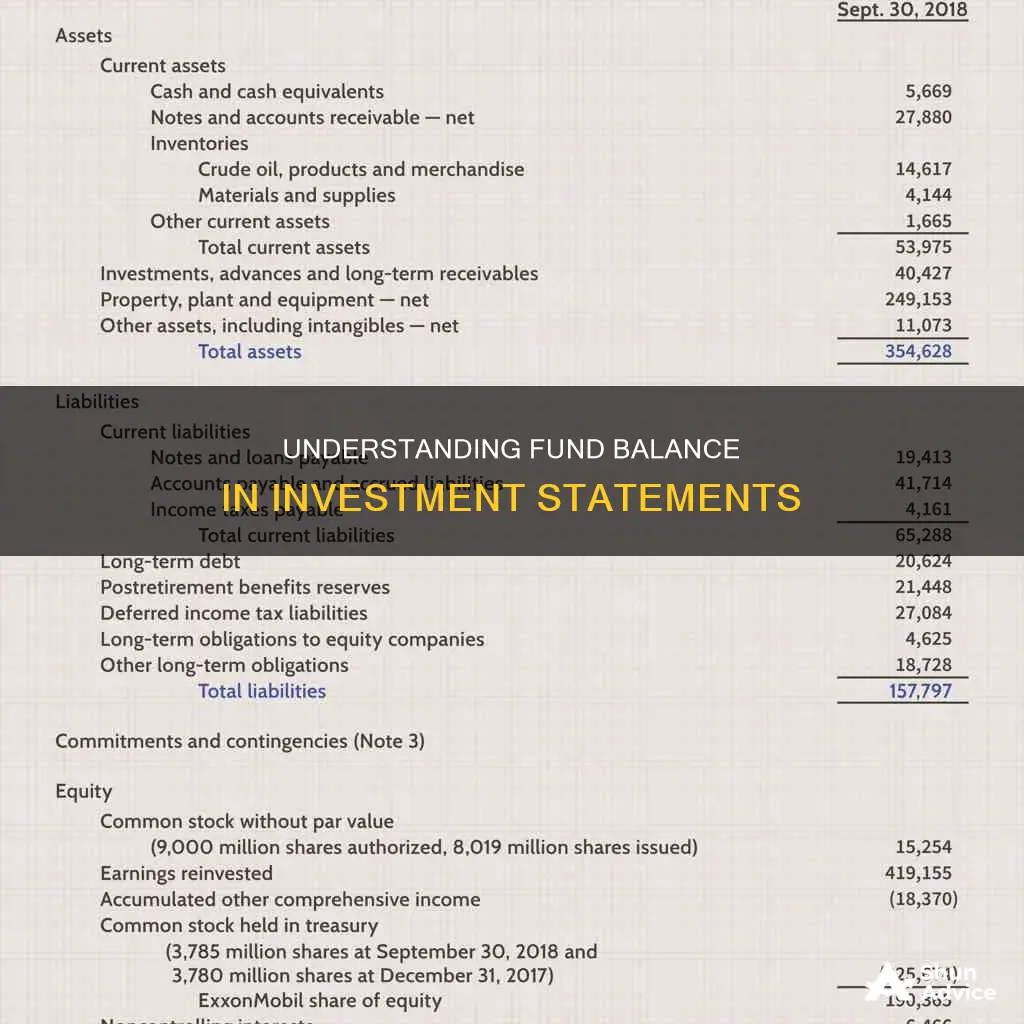
A fund balance, in the context of financial reporting, is a term used to describe the net position of a government's funds, calculated in accordance with generally accepted accounting principles (GAAP). The fund balance is intended to serve as a measure of the financial resources available to a government. It is reported from the perspective of the underlying resources within the fund, and identifies constraints on how resources can be spent and the sources of those constraints. The balance sheet, or statement of fund balance, is a part of the financial reporting that governmental entities are required to prepare annually, and it summarises the allocation of all governmental funds.
What You'll Learn

Non-spendable fund balance
A non-spendable fund balance is a portion of the fund balance that reflects assets not in a spendable form. This could be because they will never be converted to cash, such as prepaid items, or because they must remain intact due to legal or contractual requirements, like the principal of a permanent endowment.
The classification of non-spendable fund balances is important in financial reporting, particularly for governmental funds. It helps to identify the constraints on how resources can be spent and the sources of those constraints. In the context of financial reporting, the term "fund balance" describes the net position of governmental funds, calculated according to generally accepted accounting principles (GAAP). Budget professionals also use this term to describe the net position of governmental funds from a budgetary perspective.
It is important to note that the calculation of GAAP fund balance and budgetary fund balance can be complicated by the use of sub-funds within the general fund. In such cases, the GAAP fund balance includes amounts from all sub-funds, while the budgetary fund balance typically does not. Additionally, the timing of revenue and expenditure recognition may differ for GAAP and budgetary purposes. For example, encumbrances from purchase orders are often recognised as expenditures for budgeting but not for GAAP financial statements.
To summarise, a non-spendable fund balance represents assets that cannot be spent, either because they are not in a spendable form or due to legal or contractual obligations. This classification is an important aspect of financial reporting, particularly for governmental funds, and helps to provide transparency and clarity regarding the constraints and sources of fund balances.
Income Funds: A Guide to Smart Investing
You may want to see also

Restricted fund balance
A fund balance is the difference between a government's assets and liabilities in a fund balance sheet. It is a measure of the financial resources available in a governmental fund and is widely used by users of financial statements.
Restrictions on a restricted fund balance may only be changed or lifted with the consent of the resource providers. For example, if a government agency receives grant money from an external provider, the grant money may be restricted to being spent on a specific project or initiative. The agency can only spend the money on that project unless the provider agrees to lift or change the restriction.
Index Funds: Investing via Apps
You may want to see also

Committed fund balance
A committed fund balance is a category of fund balance that is reported in a government's financial statements. It is one of the five categories of fund balance based on the type and source of constraints placed on how resources can be spent. The other categories are nonspendable fund balance, restricted fund balance, assigned fund balance, and unassigned fund balance. The total of the amounts in the last three categories (committed, assigned, and unassigned) is termed unrestricted fund balance.
A committed fund balance includes amounts that can only be used for specific purposes. These constraints on the use of the funds are imposed by formal action from the state's highest level of decision-making authority, typically the legislature. These committed amounts cannot be used for any other purpose unless the imposing authority removes or changes the specified use through the same type of action. Many of the General Revenue-Dedicated funds have a committed fund balance.
The calculation of a committed fund balance can be complicated by the use of sub-funds within the general fund. In such cases, the fund balance includes amounts from all of the sub-funds. Additionally, the timing of revenue and expenditure recognition can differ for purposes of GAAP financial reporting and budgeting. For example, encumbrances from purchase orders are recognised as expenditures for budgetary purposes but not for GAAP financial statements.
It is important for governments to maintain adequate levels of fund balance, including committed fund balances, to mitigate current and future risks, such as revenue shortfalls and unanticipated expenditures, and to ensure stable tax rates. Governments should establish formal policies on the level of unrestricted fund balance that should be maintained in the general fund for GAAP and budgetary purposes.
S&P Target Date 2025 Index Mutual Funds: Smart Investment Strategy
You may want to see also

Assigned fund balance
An assigned fund balance is a category of fund balance that comprises amounts intended to be used by the government for specific purposes. The intent for these funds to be used for a specific purpose can be expressed by the governing body, an official, or a body to which the governing body delegates authority.
In governmental funds other than the general fund, the assigned fund balance represents the amount that is not restricted or committed. This indicates that resources in other governmental funds are, at a minimum, intended to be used for the purpose of that fund.
The assigned fund balance is one of the categories that make up the unrestricted fund balance. The unrestricted fund balance is the total of the amounts in the restricted, committed, and assigned fund balance categories, where the only constraint on spending, if any, is imposed by the government itself.
In the state of Texas, the assigned fund balance is greater than the total fund balance. A negative unassigned fund balance can only be reported if the total fund balance is negative, and only after all other fund balance classifications are exhausted.
True Beacon Hedge Fund: Investment Strategies and Opportunities
You may want to see also

Unassigned fund balance
A fund balance is a measure of the financial resources available in a governmental fund. In the context of financial reporting, the term fund balance is used to describe the net position of governmental funds calculated in accordance with generally accepted accounting principles (GAAP).
The Governmental Accounting Standards Board (GASB) identifies five separate categories of fund balance based on the type and source of constraints placed on how resources can be spent. These are:
- Non-spendable fund balance
- Restricted fund balance
- Committed fund balance
- Assigned fund balance
- Unassigned fund balance
The unassigned fund balance is the residual classification for the general fund and includes all amounts not contained in the other classifications. Unassigned amounts are technically available for any purpose.
In the case of a surplus fund balance, the net resources of the general fund in excess of non-spendable, restricted, committed, and assigned fund balances are classified as unassigned. In the case of a deficit fund balance, the excess of non-spendable, restricted, and committed fund balances over total fund balance is classified as unassigned.
The unassigned fund balance is an important measure of a government's financial strength. It is essential that governments maintain adequate levels of fund balance to mitigate current and future risks, such as revenue shortfalls and unanticipated expenditures, and to ensure stable tax rates.
The use of unassigned funds to balance a budget is a recommended practice. Governments should establish a formal policy on the level of unrestricted fund balance that should be maintained in the general fund for GAAP and budgetary purposes. This policy should articulate a framework and process for how the government would increase or decrease the level of unrestricted fund balance over a specific time period.
Land vs Mutual Funds: Where Should You Invest?
You may want to see also
Frequently asked questions
Fund balance is the net position of governmental funds calculated in accordance with generally accepted accounting principles (GAAP). It is a measure of the financial resources available in a governmental fund.
There are five separate categories of fund balance: non-spendable fund balance, restricted fund balance, committed fund balance, assigned fund balance, and unassigned fund balance.
Fund balance can be calculated using the following formula: Fund Balances = Assets + Deferred outflow of resources – Liabilities – Deferred inflow of resources.
GAAP fund balance includes amounts from all sub-funds within the general fund, whereas budgetary fund balance typically does not. Additionally, the timing of revenue and expenditure recognition can differ between the two.
Fund balance is important because it helps governments ensure that the correct amount of money is spent in the right areas and that funds are not overspent or underspent irresponsibly.







